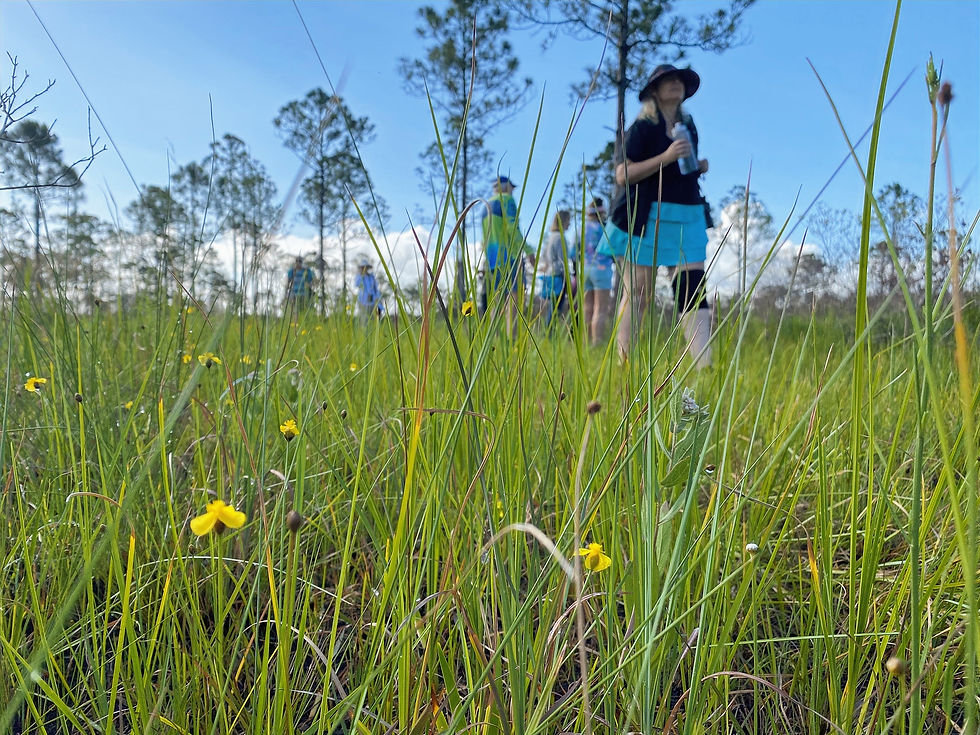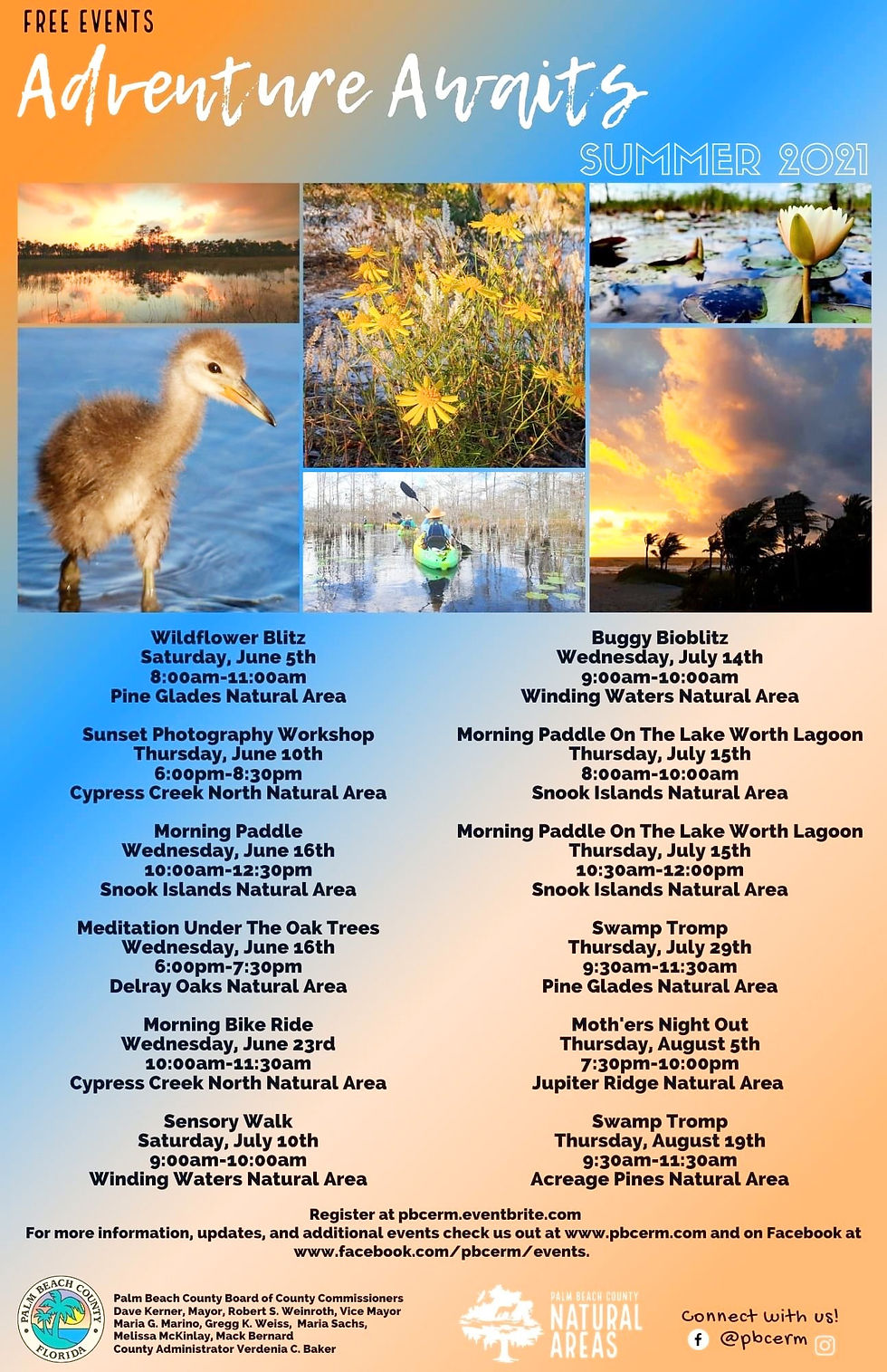WILDFLOWER POWER! In search of Swamp Cheetos, Milkweed and other eye candy blooming in the sticks
- Jun 8, 2021
- 5 min read
Updated: Jun 9, 2021

THE WILDLANDS BEYOND northern Palm Beach County's urban core might look empty, but they are stocked with an abundance of curious inventory.
There are snack chips, fashion accessories and locks of hair, to name a few.
It's all out there, blooming in the secluded wildflower patches deep in the 6,651-acre Pine Glades Natural Area west of Jupiter Farms.

You just have to know where to look.
Of course, it helps to have a knowledgable guide or two, like the biologists with Palm Beach County’s Department of Environmental Resources Management who led this past Saturday’s “Wildflower Blitz.’’

At the end of three-hour sensory excursion, one takeaway bloomed brightest for wildflower newbies:
It’s a lot easier, and much more amusing, to be introduced to Swamp Cheetos and Hat Pins and Ladies' Tresses than to Polygala lutea and Eriocaulon decangulare and Spiranthes laciniata.
Kicking off ERM’s “Adventure Awaits” summer series of outdoor events, the tour highlighted the natural wonders in South Florida’s interior and the important role wildflowers play in the ecosystem.

And the first lesson for novices became apparent in the opening minutes of the tour: Finding wildflowers can be as challenging as pronouncing their Latin names.
While some, like the eye-catching purple Everglades Morning Glory (Ipomoea sagittata), are hard to miss, many others are camouflaged among the grass and plants.
“They are not something you typically look at from a distance and know what you are looking at,’’ Sally Channon, a senior environmental analyst at ERM.

“But if you're one of those people who like (puzzles such as) ‘find the six differences between these drawings,’ then you’re ready to look at wildflowers.’’
With that disclaimer, the 26 guests, many of them passionate wildflower connoisseurs, piled into the backs of four pickup trucks for a 2-mile drive into the interior.

The roar of traffic on Indiantown Road disappeared as the caravan rumbled past fields, cypress strands and a narrow lake where the bulging eyes of a patrolling alligator breached the surface like periscopes.
Near the end of the Quail Trail, the trucks slowed to a halt.

Participants jumped out into grass dotted with the bright pink leaves of the Marsh-pink, an herbaceous bloomer identified by the hikers who brought wildflower guidebooks.
Smartphones came in handy, too. Flower watchers thumbed iNaturalist, Seek and other apps to identify Pickerelweed, Beautyberry and Eupatorium. (But we would also learn that even those apps can get confused!)

The hikers meandered down the Wiregrass Trail, where the early-morning sun cast long shadows off the slash pines and cabbage palms on the prairies and flatwoods.
And before long, they broke off into different directions, lured by the many colorful blooms beaming from the tall grass.

Jerome Small of West Palm Beach aimed his phone at droopy white star-shaped leaves that look like petals.
He tapped the Google Lens app, which in seconds spit out "Starrush Whitetop." Turns out the app was wrong, Channon said. The plant Small photographed was actually the Rhynchospora latifolia, commonly known as the "Giant White Top."

Participants without apps and guidebooks were fortunate to hike alongside Stephanie Dunn, a Boca Raton resident who seemed to know as much about wildflowers as any app or guidebook.
A proud member of the Florida Native Plant Society, she carried a creased copy of The Complete Guide to Florida Wildflowers by naturalist Roger L. Hammer. She didn’t need to consult it much.
Watching Dunn rave about an Asclepias Lanceolata, it was obvious that this wasn’t her first wildflower tour, nor will it be her last.

“Wildflowers are beautiful to look at,’’ she said.
“And they don’t take off, like birds,’’ Lori Pasko, an avid birder, chimed in.
Dunn laughed and continued explaining her passion.

"They’re a great gateway for people to start to think about, OK, see the flower, it’s this type of habitat. How is that habitat managed and how does it provide for birds and other wildlife?’’
It was Dunn who made a dozen or so others crack up when she pointed out the yellow-orange spikes of the aptly-named Swamp Cheeto, also known as a Bog Cheeto and Orange Milkwort.

Swamp Cheetos rank among the most fun names of wildflowers worldwide, a lineup that includes the bleeding heart and lizard’s tail and the pink lady’s slipper and the famous jack-in-the-pulpit that inspired artist Georgia O’Keeffe. (None of those were seen on Saturday’s hike.)
And since you’re wondering, Swamp Cheetos do not taste at all like real Cheetos. But their roots do taste and smell like licorice or, as in the opinion of one participant, “a Wint-O-Green Lifesaver.’’
Dunn made sure the group didn’t miss a spectacular Saltmarsh Morning Glory with petals so big she spotted them from 30 yards.

“That's some megaflora right there,’’ she said, snapping a photo of a wildflower that impressed even her. “The leaves are a lot narrower than other Morning Glories.’
Most of the wildflowers were much smaller and best viewed through palm-sized magnifying glasses loaned by Channon, environmental analyst Carrie Black Finch and other ERM staff.

Dunn didn’t need help spotting a tiny caterpillar perched on the bud of a Fewflower milkweed.
“Oh, wow! Good eyes,” Eric Parsons told Dunn as others in the group crowded in for a closer look at nature — and the importance of wildflowers — in action.


While many native flowers can be found in yards and on roadsides, most of those found on the “Wildflower Blitz” grow only in wilderness areas like Pine Glades.
“I'm from the Midwest and I've never experienced wildflowers like this before,’’ said Tony Pasko, a Michigan snowbird from Jupiter, who was enjoying his first group excursion since the start of the pandemic.

Pasko, an avid birdwatcher, said he enjoys Florida's ground orchids.
“We have flowers (in the Midwest),’’ he said, “but we have a lot of tree cover and pines so the sunlight never hits the ground. I’ve never seen flowers like this.’’

The “Wildflower Blitz” kicked off ERM’s summer “Adventure Awaits” tours of the county’s natural areas.
The remaining 11 tours, all free, will include a sunset photography workshop, swamp stomps, bike rides, kayaking, even “meditation under the oaks.’’

To register, use the department’s Eventbrite page, PBCERM.EVENTBRITE.COM.
Click the “follow” button to receive email notifications when events open for registration.
Seema Michon was among the “Adventure Awaits” veterans who attended the wildflower tour.
“I love hiking. I'm always here in Pine Glades and Riverbend (Park) and I see these beautiful little flowers that grow in the wild. I just wanted to know a little bit more about it,'' she said after taking several photos of the Saltmarsh Morning Glory.
"Unfortunately I don’t know too many people who are interested in this stuff. They’d rather go to the mall or sit by the pool. I guess I’m just a little bit different. This is what I love. We are so fortunate to live here so close to all of this.’’
Here's a list of the 50 species of plants — not only wildflowers, but also grasses and sedges — found on the tour:


© 2021 ByJoeCapozzi.com All rights reserved.
Sign up for a free subscription to ByJoeCapozzi.com
IN CASE YOU MISSED my previous blog: The Tale of the Two-Tailed Lizard that Inspired a Lake Worth Beach Writer to Create Children's Books
MUSIC FROM OTHER KEYBOARDS
Helen Rosner in The New Yorker: Lilac Syrup and the Underrated Art of Eating Flowers
Lindsay Zoladz in the New York Times: The Raw Roots of Tom Petty’s ‘Wildflowers,’ Revealed at Last
Alex Wigglesworth in the Los Angeles Times: A generation of seabirds was wiped out by a drone. Scientists fear for their future.




